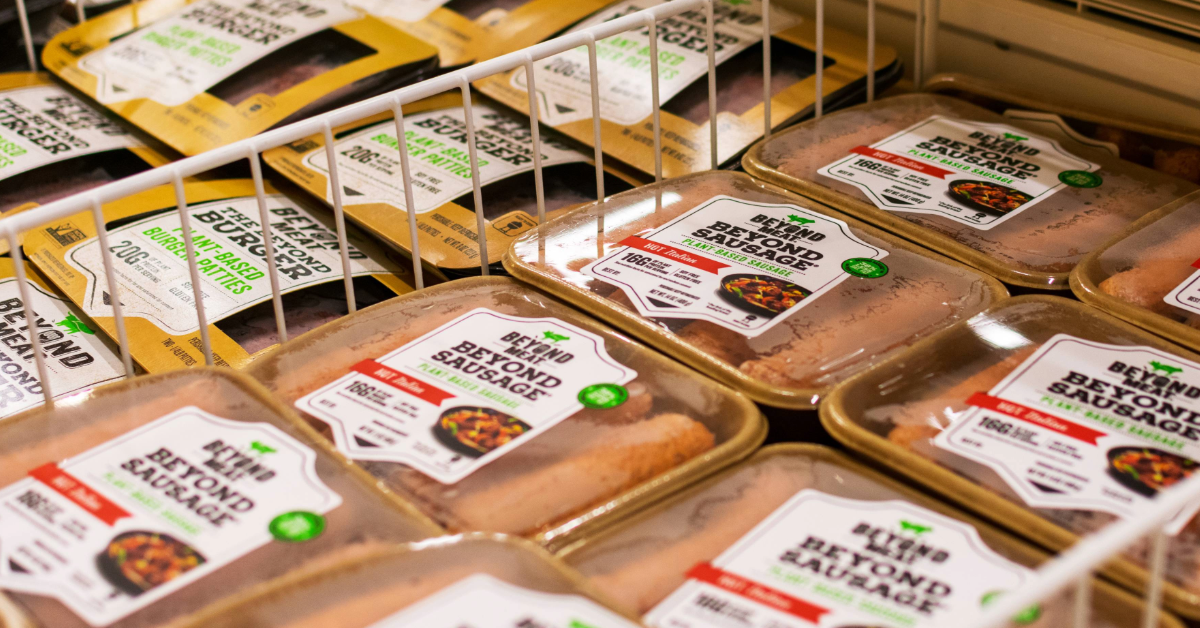
Here at Mewburn Ellis, we have been thinking about the future of food for some time. Since 2019, we have remained keen commentators on this emerging field ever since, with Fay Allen first reviewing the state of plant-based proteins in September 2020. The rate of development in this area, however, has surprised even us. In addition to the explosion of plant-based products on supermarket shelves, there has been a flurry of patent filings over recent years. In this special Veganuary article, we explore the cutting edge of plant-based proteins, by looking at recent patent filings.
Plant-Based Meat Analogues – a history
Meat-free diets have been adopted for religious or ethical reasons for millennia, and foods such as tofu and tempeh dating back to before recorded history. However, in more recent decades, innovation has driven a shift from simply providing an alternative source of protein to meat, to crafting increasingly faithful substitutes. The story of the first generation of plant-based meat analogues is one of “filling the hole in the plate”. Products such as textured vegetable protein (TVP), or mycoprotein-derived Quorn provided much-needed alternatives to meat for the burgeoning vegetarian movement. However, these were primarily marketed to those already committed to a meat-free diet and, despite accumulating improvements in taste and texture, did not find mass appeal with omnivores. This has changed in recent years, as an explosion of “Next-Gen” analogues seek not only to provide acceptable substitutes for those with no alternative, but provide appealing like-for-like substitutes and even surpass conventional meat for a mainstream audience.
Despite the considerable advancement in this area, and with increasing interest from “Big Meat” (large companies who produce pork, chicken and beef in industrial quantities), there remains significant scope for further innovation. The trends in patent filing suggest several areas in which we may see further development, and can provide inventors with insights into how to build valuable commercial protection around their next-gen products.
“Flavour” vs “Taste” – taking a holistic view
Whilst reproducing flavours is fairly well-developed, “taste” is far more complex than a simple chemical formulation. Many meats and dairy products change flavour as they are heated, and this can depend on how the heating occurs. The release of volatile compounds, thermolytic breakdown of complex flavour molecules, and formation of new ones through processes such as the Maillard reaction all contribute to the overall sense of “flavour”. Identifying the agents underlying these processes will lead to better flavour profiles.
A well-known example of this is the soy leghaemoglobin used by US-based Impossible Foods, which serves as an analogue for haem found in the blood of red meat. Haem undergoes complex chemical changes upon heating, and these contribute to the overall sensory profile of a cooked burger or steak. Recombinantly produced soy leghaemoglobin, as made by genetically-engineered yeast, is an efficient and convincing analogue which sets the products of Impossible Foods apart from their competitors.
In the future, we would expect to see more of these increasingly sophisticated “secret ingredients” emerge as innovators set their sights on reproducing the full spectrum sensory eating profile of conventional meats. IP rights will be particularly important aspect of protecting these ingredients as they become further removed from those with histories of edibility, as the need to meet regulatory requirements for new ingredients necessitates disclosure and removes the option of relying on trade secrets and “secret recipes.
However, the plant-based sector is becoming a highly contested space, as challenges to key haem patents in European opposition and at the US Patent Trial and Appeal Board (PTAB) show. As competition increases, it will be important that innovators obtain robust protection around these key ingredients, through astute drafting, skilled prosecution, and by utilising the full range of available IP rights to create overlapping layers of protection able to withstand challenge in court.
All sizzle, no steak – enhancing “cookability”
As any chef who has worked with both animal-derived products and their plant-based analogues can attest, there can be no mistaking them in the kitchen. The “cookability” of foods is the result of a complex interplay between fat and protein microstructures as they melt, denature, and are chemically altered by heat. The subtle rendering of bacon fat in a warming pan, the melting and blistering of cheese under a hot grill without splitting, or the different ways eggs coagulate when gently simmered as a custard or exposed to the searing heat of an omelette have not yet been matched by plant-based substitutes.
UK plant-based firm THIS aim to address this with their proprietary “Fat 2.0” composition, and their sausages were convincing enough to dupe visitors and experts alike at a major food exhibition into believing their products were “actual” meat. How it works is unclear, but clues might be found in a patent filed by the company in 2022, which describes a fat composition obtained through blending plant-based oils with an edible plant-derived gum. The resulting fat is solid at higher cooking temperature, yet renders to slowly release oil when cooked, resulting in the combination of a crispy outside and chewy inside characteristic of animal fats. Advantageously, this provides the juiciness and rendering properties of “real” meats, with significantly less saturated fat, going beyond simple mimicry and in some respects surpassing the animal products for which it substitutes. We might expect that similar technologies intended to increase the mimicry of plant-based foods will one day be harnessed to improve health profiles, providing a strong nutritional argument for abandoning animal proteins alongside the environmental and ethical ones we see today. Indeed, we may even see the blending of plant-based ingredients and animal tissues to produce healthier processed meats for carnivores.
From a patenting perspective, advances in “cookability” avoid some of the challenges involved in flavouring compounds. The need to describe inventions accurately can make qualities such as improved taste and aroma challenging to claim, as these are ultimately subjective and relative. In contrast, “cookability” characteristics may be easier to describe objectively – changes in weight, colouring or fat content following heating, for example, may be quantified – even if these properties also result in improvements in eating experience.
The rough and the smooth – texturing and advanced processing
Like many of the meat products they seek to replace, plant-based meat analogues are highly processed products. Many of the processing steps are required to turn plant sources of protein, which typically have high moisture contents and low cohesiveness, into something capable of holding together on the fork. However, significant advances are still possible through manipulating processing steps such as emulsification, stabilising, extrusion, and heating, to improve the mimicry and appeal of new foods. For example, the vegan “Bakon” strips produced by Thrilling Foods attract rave reviews and a cult following, and appear to owe their properties to a clever combination of processing steps. Published patent applications suggest that this is achieved through alternate layering of fat-enriched and unenriched tofu layers laced with flavourings. This is necessary, as whilst fat is vital for the taste and texture of bacon, the addition of fat to tofu normally compromises durability. The laminated structure overcomes this limitation, and is reminiscent of the alternating fatty-and-lean layers of pork belly bacon. As part of the process, the application also describes applying mild heat and pressure to drive “syneresis” – the process through which protein bonds tighten over time, forcing out liquids – resulting in a product which is firmer, more durable, and more sliceable. This combination of processing steps produces a food far removed from conventional tofu.
Inventions around new processing steps pose their own challenges for patent protection. Alongside claims to methods of production, applicants frequently aim to protect products directly. Patent offices are in general reluctant to allow so-called “product by process” claims (e.g. “product X produced by method Y”), preferring products to be defined solely by physical characteristics. For food products, whilst process steps can obviously result in new products, these differences may be hard to define, and applicants can face an uphill battle to obtain protection. Solutions to this may be found in materials science, where this problem is well-known. Regardless, inventors will once again benefit from an IP strategy that provides multiple overlapping layers of rights which, viewed as a whole, provide broad and extensive protection.
As ever, the next wave of innovation is difficult to predict. However, what seems certain is that plant-based meat analogues will only continue to improve, becoming ever more convincing replacements for the “real” thing. Perhaps one day, if they have not already, they will convince you?
This blog was originally written by Andrew Tindall.
Lauren is a trainee patent attorney working in our Life Sciences team. Lauren has a degree in Biochemistry from the University of York. She undertook a one year industry research placement in neurodegenerative diseases at the DZNE in Bonn. Her undergraduate research project focused on developing hydrogel biomaterials for stem cell growth. Following her degree, Lauren spent 18 months doing academic research at the Institute of Prion Diseases, specialising in whole-organ imaging.
Email: lauren.woolley@mewburn.com
Sign up to our newsletter: Forward - news, insights and features
Our people
Our IP specialists work at all stage of the IP life cycle and provide strategic advice about patent, trade mark and registered designs, as well as any IP-related disputes and legal and commercial requirements.
Our peopleContact Us
We have an easily-accessible office in central London, as well as a number of regional offices throughout the UK and an office in Munich, Germany. We’d love to hear from you, so please get in touch.
Get in touch

